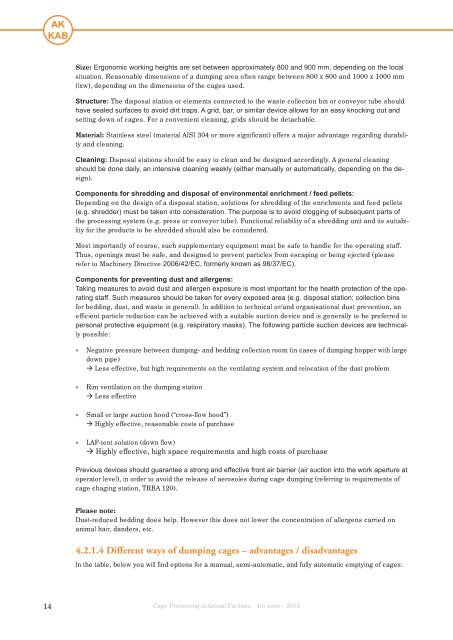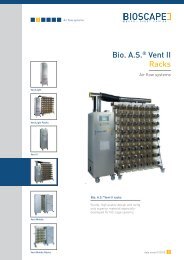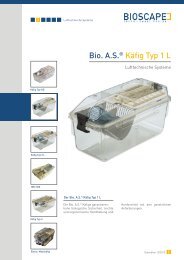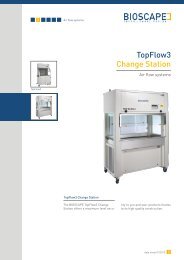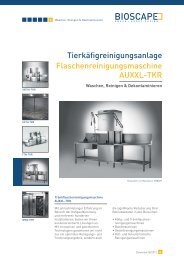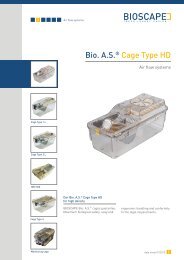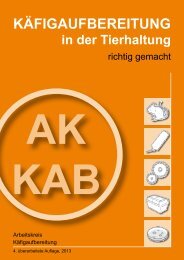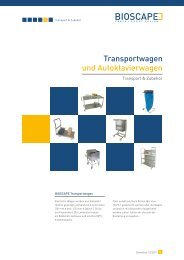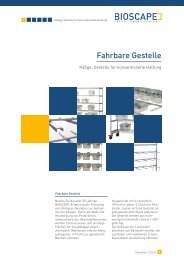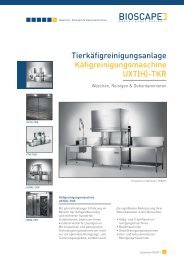CAGE PROCESSING in Animal Facilities - GV-SOLAS
CAGE PROCESSING in Animal Facilities - GV-SOLAS
CAGE PROCESSING in Animal Facilities - GV-SOLAS
Create successful ePaper yourself
Turn your PDF publications into a flip-book with our unique Google optimized e-Paper software.
Size: Ergonomic work<strong>in</strong>g heights are set between approximately 800 and 900 mm, depend<strong>in</strong>g on the localsituation. Reasonable dimensions of a dump<strong>in</strong>g area often range between 800 x 800 and 1000 x 1000 mm(lxw), depend<strong>in</strong>g on the dimensions of the cages used.Structure: The disposal station or elements connected to the waste collection b<strong>in</strong> or conveyor tube shouldhave sealed surfaces to avoid dirt traps. A grid, bar, or similar device allows for an easy knock<strong>in</strong>g out andsett<strong>in</strong>g down of cages. For a convenient clean<strong>in</strong>g, grids should be detachable.Material: Sta<strong>in</strong>less steel (material AISI 304 or more significant) offers a major advantage regard<strong>in</strong>g durabilityand clean<strong>in</strong>g.Clean<strong>in</strong>g: Disposal stations should be easy to clean and be designed accord<strong>in</strong>gly. A general clean<strong>in</strong>gshould be done daily, an <strong>in</strong>tensive clean<strong>in</strong>g weekly (either manually or automatically, depend<strong>in</strong>g on the design).Components for shredd<strong>in</strong>g and disposal of environmental enrichment / feed pellets:Depend<strong>in</strong>g on the design of a disposal station, solutions for shredd<strong>in</strong>g of the enrichments and feed pellets(e.g. shredder) must be taken <strong>in</strong>to consideration. The purpose is to avoid clogg<strong>in</strong>g of subsequent parts ofthe process<strong>in</strong>g system (e.g. press or conveyor tube). Functional reliability of a shredd<strong>in</strong>g unit and its suitabilityfor the products to be shredded should also be considered.Most importantly of course, such supplementary equipment must be safe to handle for the operat<strong>in</strong>g staff.Thus, open<strong>in</strong>gs must be safe, and designed to prevent particles from escap<strong>in</strong>g or be<strong>in</strong>g ejected (pleaserefer to Mach<strong>in</strong>ery Directive 2006/42/EC, formerly known as 98/37/EC).Components for prevent<strong>in</strong>g dust and allergens:Tak<strong>in</strong>g measures to avoid dust and allergen exposure is most important for the health protection of the operat<strong>in</strong>gstaff. Such measures should be taken for every exposed area (e.g. disposal station; collection b<strong>in</strong>sfor bedd<strong>in</strong>g, dust, and waste <strong>in</strong> general). In addition to technical or/and organisational dust prevention, anefficient particle reduction can be achieved with a suitable suction device and is generally to be preferred topersonal protective equipment (e.g. respiratory masks). The follow<strong>in</strong>g particle suction devices are technicallypossible:• Negative pressure between dump<strong>in</strong>g- and bedd<strong>in</strong>g collection room (<strong>in</strong> cases of dump<strong>in</strong>g hopper with largedown pipe) Less effective, but high requirements on the ventilat<strong>in</strong>g system and relocation of the dust problem• Rim ventilation on the dump<strong>in</strong>g station Less effective• Small or large suction hood (“cross-flow hood”) Highly effective, reasonable costs of purchase• LAF-tent solution (down flow) Highly effective, high space requirements and high costs of purchasePrevious devices should guarantee a strong and effective front air barrier (air suction <strong>in</strong>to the work aperture atoperator level), <strong>in</strong> order to avoid the release of aerosoles dur<strong>in</strong>g cage dump<strong>in</strong>g (referr<strong>in</strong>g to requirements ofcage chag<strong>in</strong>g station, TRBA 120).Please note:Dust-reduced bedd<strong>in</strong>g does help. However this does not lower the concentration of allergens carried onanimal hair, danders, etc.4.2.1.4 Different ways of dump<strong>in</strong>g cages – advantages / disadvantagesIn the table, below you will f<strong>in</strong>d options for a manual, semi-automatic, and fully automatic empty<strong>in</strong>g of cages:14Cage Process<strong>in</strong>g <strong>in</strong> <strong>Animal</strong> <strong>Facilities</strong> · 4th issue · 2013


